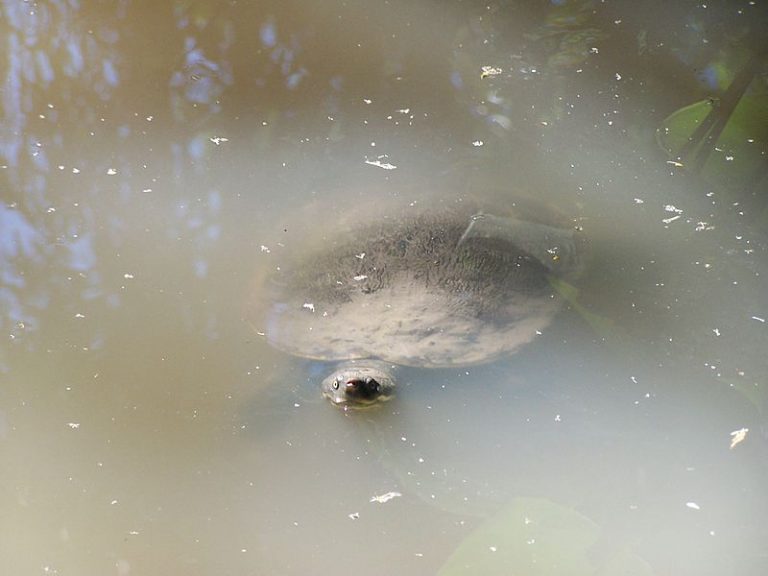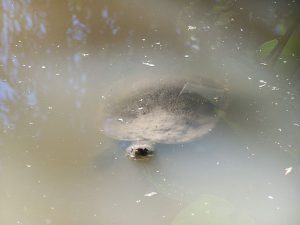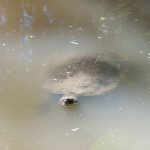
Mary River turtle. (Photo by NKGKing, distributed by WikiMedia Commons under CC BY-SA 3.0 licence)
Table of Contents
The Mary River Turtle (Elusor macrurus) has been named recently as one of the species on the brink of extinction. That is according to the Evolutionary Distinct and Globally Endangered (EDGE) Reptiles list of Zoological Society of London. Some would probably shrug it off with a gibbering murmur that the rule of the game is, by the way, the “survival of the fittest”. However, this meek creature would probably not deserve a slot in the list had it not been struggling against hunters that put a tag on it. Why is the Mary River turtle endangered is due to the threat looming its survival as grim as losing it — with all its fascinating biological features and ecological significance — forever.
Rare biological traits
The Mary River turtle has been a popular exotic pet since the 1960s and 1970s. A reptile biologist at Zoological Society London, Rikki Gumbs, explained that the turtle was popular because of its uncanny biological traits.1 It is one of the few animals that ”breathe” oxygen via their cloaca. Its cloaca serves as both the genitals and the anus. Thus, aside from the obvious biological functions (i.e. for excretion and mating), its cloaca is also specialized for respiration. While the turtle regularly comes to the surface to breathe air via its nostrils, it also “breathes” while underwater. The gill-like organs within its cloaca absorb oxygen enabling the turtle to stay submerged for three days.2 Because of its ability to stay underwater for that long, it is not unusual to find one that forms a symbiosis with algae. Strands of algae grow atop its head and shell. Sporting a “fancy mohawked hairdo”, the turtle is also called the “green-haired turtle”. Another distinctive feature is its tail. Males, in particular, can grow a tail to almost two-thirds of the carapace length and adorned with hemal arches. This turtle also has remarkably long barbels (a pair of slender tactile organs) under the chin.
Mary River turtle – why it is endangered
Why the Mary River turtle is endangered is due to their currently small population. The species was already in the pet trade during the 1960s and 1970s before it was first described formally as a species in the 1990s. Thus, their numbers dwindled over time as a lot of them had been lost by nest pillaging and pet trade before the cognizance of the risk of it being endangered. Another unfortunate fact was the conservation efforts of endangered reptiles were raised only of late. Gumbs was quoted, “Reptiles often receive the short end of the stick in conservation terms, compared with the likes of birds and mammals.”2 In the recent list of Top 100 EDGE Reptiles, the Mary River turtle came at no. 29. 3 Conservation strategies are hoisted to help boost their population. However, one of the factors that made the species vulnerable to extinction is the exceptionally long time it takes for them to become sexually mature, i.e. about 25 to 30 years.1
Saving “Mary River turtle” and other endangered reptiles
The endangered reptiles are apparently overlooked compared with the other groups of endangered animals. They had not received the same gravity of attention and popularity as the endangered mammals and birds had. The reptiles were often overlooked, perhaps, because of the far-from-cuddly looks that made them seem less appealing. The list released this year by the Zoological Society of London’s EDGE now includes reptiles. At the top of the list is the critically endangered Madagascar big-headed turtle (Erymnochelys madagascariensis).3 So, why did the Mary River turtle get more attention past the other more critically endangered reptiles on the list? Apart from its captivating punky look, the species is the only member of its genus and became evolutionary distinct 40 million years ago. 3 However, despite being evolutionary distinct for that long, the Mary River turtle became vulnerable to extinction largely due to human intrusions. Now, the species is protected by Australian government laws and more conservation efforts are underway.
The awareness of the need for more concerted efforts to conserve seemingly sturdy, robust reptiles is crucial for their survival. Failure to notice early on the need for conservation efforts accentuated the odds of the species extinction. The Mary River turtles are able to thrive and live for many million years, and yet, in a relatively short span of time of human interventions and exploitations, they are now on the dreaded list together with the rest of the endangered reptiles that would, one day, bid farewell for good – unless effective conservation strategies are implemented on time.
— written by Maria Victoria Gonzaga
References
1Mahmood, Z. (2018). Australian ‘genital-breathing’ turtle faces extinction, group says. Retrieved from https://edition.cnn.com/2018/04/12/asia/mary-river-turtle-endangered-intl/index.html
2 Graham, B. (2018). Punk rocker Mary River turtle now one of the most endangered reptile species on the planet. Retrieved from http://www.news.com.au/technology/science/animals/punk-rocker-mary-river-turtle-now-one-of-the-most-endangered-reptile-species-on-the-planet/news-story/44e0f028840e40dac3c46f884ca7c967
3“TOP 100 EDGE REPTILES”. (2018). Retrieved from https://www.edgeofexistence.org/species/species-category/reptiles/
Recommended Sources
- Conservation Physiology – a fully open access journal focused on understanding and predicting how organisms, populations, ecosystems and natural resources respond to environmental change and stressors.

